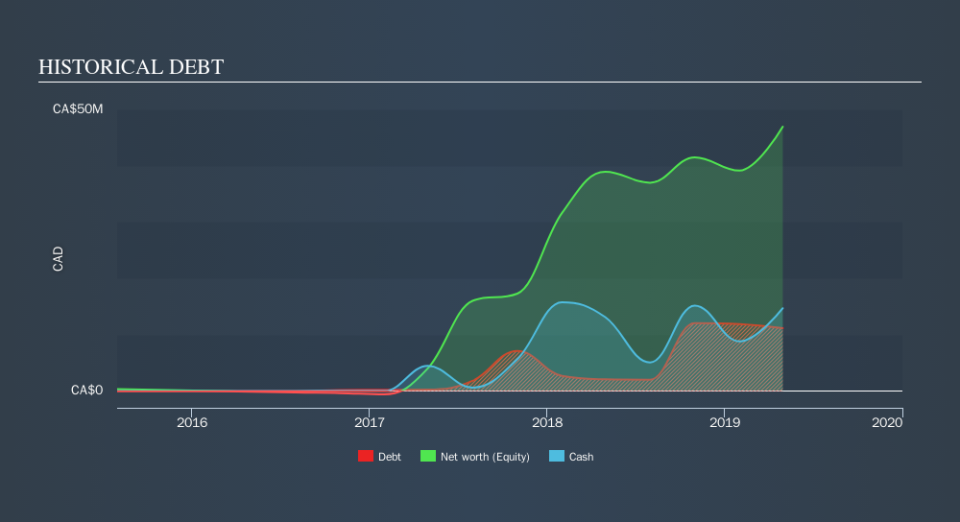Is 1933 Industries (CNSX:TGIF) Using Debt In A Risky Way?

Warren Buffett famously said, 'Volatility is far from synonymous with risk.' So it seems the smart money knows that debt - which is usually involved in bankruptcies - is a very important factor, when you assess how risky a company is. We can see that 1933 Industries Inc. (CNSX:TGIF) does use debt in its business. But the real question is whether this debt is making the company risky.
Why Does Debt Bring Risk?
Generally speaking, debt only becomes a real problem when a company can't easily pay it off, either by raising capital or with its own cash flow. In the worst case scenario, a company can go bankrupt if it cannot pay its creditors. However, a more frequent (but still costly) occurrence is where a company must issue shares at bargain-basement prices, permanently diluting shareholders, just to shore up its balance sheet. Of course, plenty of companies use debt to fund growth, without any negative consequences. The first step when considering a company's debt levels is to consider its cash and debt together.
View our latest analysis for 1933 Industries
How Much Debt Does 1933 Industries Carry?
You can click the graphic below for the historical numbers, but it shows that as of April 2019 1933 Industries had CA$11.2m of debt, an increase on CA$2.07m, over one year. However, its balance sheet shows it holds CA$14.7m in cash, so it actually has CA$3.54m net cash.
How Strong Is 1933 Industries's Balance Sheet?
Zooming in on the latest balance sheet data, we can see that 1933 Industries had liabilities of CA$3.97m due within 12 months and liabilities of CA$9.86m due beyond that. Offsetting this, it had CA$14.7m in cash and CA$2.29m in receivables that were due within 12 months. So it can boast CA$3.15m more liquid assets than total liabilities.
This surplus suggests that 1933 Industries has a conservative balance sheet, and could probably eliminate its debt without much difficulty. Simply put, the fact that 1933 Industries has more cash than debt is arguably a good indication that it can manage its debt safely. The balance sheet is clearly the area to focus on when you are analysing debt. But ultimately the future profitability of the business will decide if 1933 Industries can strengthen its balance sheet over time. So if you're focused on the future you can check out this free report showing analyst profit forecasts.
In the last year 1933 Industries wasn't profitable at an EBIT level, but managed to grow its revenue by72%, to CA$17m. Shareholders probably have their fingers crossed that it can grow its way to profits.
So How Risky Is 1933 Industries?
Statistically speaking companies that lose money are riskier than those that make money. And the fact is that over the last twelve months 1933 Industries lost money at the earnings before interest and tax (EBIT) line. And over the same period it saw negative free cash outflow of CA$22m and booked a CA$16m accounting loss. Given it only has net cash of CA$3.54m, the company may need to raise more capital if it doesn't reach break-even soon. 1933 Industries's revenue growth shone bright over the last year, so it may well be in a position to turn a profit in due course. By investing before those profits, shareholders take on more risk in the hope of bigger rewards. For riskier companies like 1933 Industries I always like to keep an eye on whether insiders are buying or selling. So click here if you want to find out for yourself.
At the end of the day, it's often better to focus on companies that are free from net debt. You can access our special list of such companies (all with a track record of profit growth). It's free.
We aim to bring you long-term focused research analysis driven by fundamental data. Note that our analysis may not factor in the latest price-sensitive company announcements or qualitative material.
If you spot an error that warrants correction, please contact the editor at editorial-team@simplywallst.com. This article by Simply Wall St is general in nature. It does not constitute a recommendation to buy or sell any stock, and does not take account of your objectives, or your financial situation. Simply Wall St has no position in the stocks mentioned. Thank you for reading.

 Yahoo Finance
Yahoo Finance 
